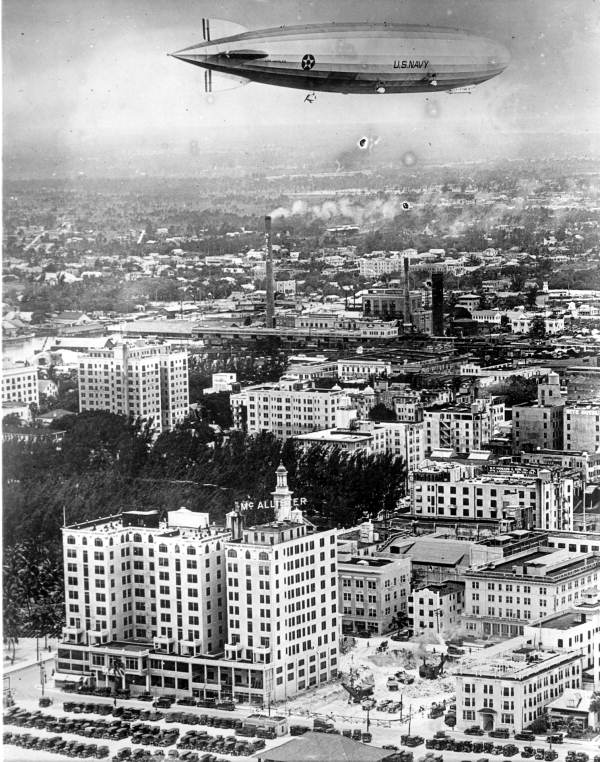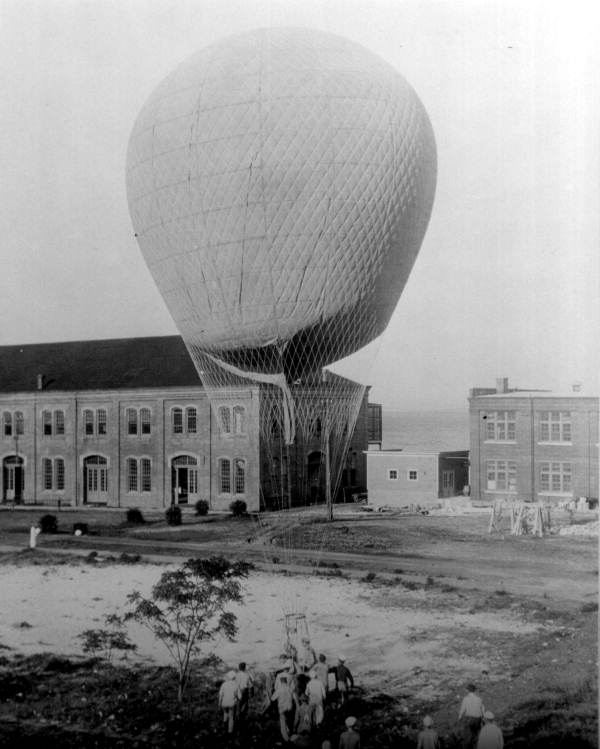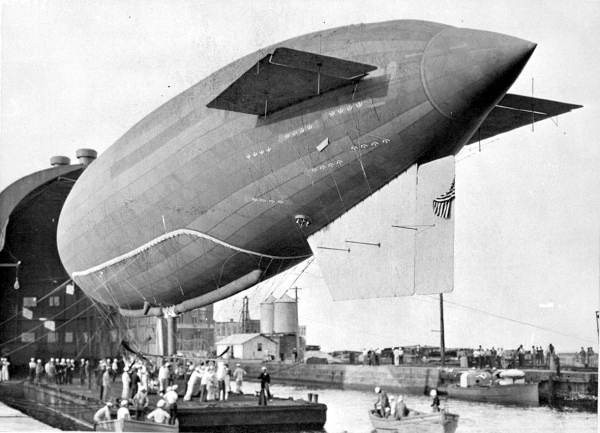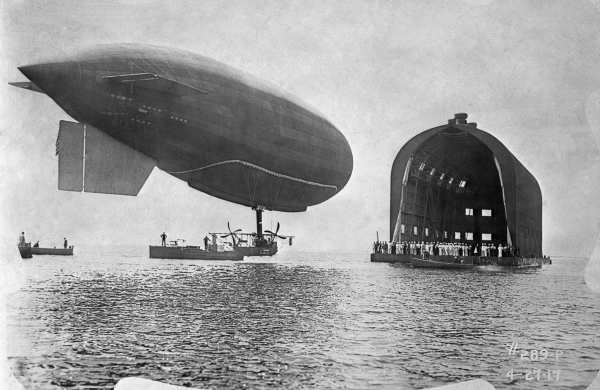Description of previous item
Description of next item
Dirigible Flights Over Pensacola
Published June 6, 2017 by Florida Memory
On July 2, 1900, the first Zeppelin flight took place near the city of Friedrichshafen on Lake Constance in southern Germany. Although the dirigible flew for approximately one hour and 15 minutes, it was difficult to steer because there was almost no directional control. The sliding weight mechanism, which controlled vertical movement, malfunctioned during the flight and caused the LZ-1, as the airship was known, to land on the lake’s surface. Unable to move on its own, the airship had to be towed back to its shed. This anticlimactic maiden voyage didn’t deter Count Ferdinand von Zeppelin from improving his design and neither did subsequent crashes of roughly 10 airships between 1900 and 1913. By the time Germany entered World War I in 1914, Zeppelins had developed into a reliable form of transportation in Germany; they were even used to transport passengers between cities.

The USS Los Angeles (ZR-3) flying over Miami, 1925. Photo by G.W. Romer. This rigid airship was built by the Zeppelin company of Germany and given to the United States as reparation for World War I.
When the war started, the German army took control of three Zeppelins and eventually expanded the fleet with airships from other manufacturers. Britain, France and Russia also each had their own fleet of airships during the war. Airships were used in combat to observe enemy troop movements and artillery, but airships also threatened civilian populations. In early 1915, Germany began using airships to conduct raids over England. Count Zeppelin had intended his airships to be used in war, yet the Zeppelins themselves were ill-equipped for this purpose. Though the airships were a frightening sight, the threat of enemy fire almost certainly spelled disaster for an airship during the war. Some airships were even accidentally shot down by their own side; and gusts of wind could easily throw the airship off course resulting in bombs being dropped miles from their intended target. But, as the war continued and airship designs became more advanced, raids by airships were more frequent and deadly.
The United States Navy’s lighter-than-air program started developing airships later than Germany and the rest of Europe. Lighter-than-air crafts, such as blimps, balloons and airships, use lifting gases to help the craft rise above the Earth’s surface (as opposed to heavier-than-air crafts, such as airplanes and helicopters, which use other features to help them rise). After Count Zeppelin’s flight in 1900, the United States began to gather information about the design and the materials used in the Zeppelin’s production. Though the U.S. Navy was unable to produce a rigid airship like the Zeppelin until the USS Shenandoah (ZR-1) in 1923, they had been developing nonrigid airships years before the U.S. even entered WWI. In fact, the U.S. Navy’s lighter-than-air program began with nonrigid airships. The difference between rigid and nonrigid has to do with the structure of the dirigible: the shape of a rigid airship is defined by its metal framework, whereas nonrigid airships will deflate without the pressure of the gases.

A U.S. Navy balloon being prepared for ascent in Pensacola as part of the lighter-than-air program, April 15, 1916. Balloons were used to monitor enemy troop movements and gather intelligence during wars dating back to the 18th century.
The development of the nonrigid airship for the U.S. Navy surpassed that of the rigid airship. In 1915, a contract was awarded to the Connecticut Aircraft Company for the Navy’s first nonrigid airship. By 1917, the U.S. Navy had its first nonrigid airship, the DN-1. The DN-1 would make its first flight at the recently constructed Naval Air Station Pensacola (NAS Pensacola). Just a few years before, Pensacola had been selected as the site of naval aviation training. In April 1917, the DN-1 arrived in Pensacola, and the airship completed its first flight on April 20.

The DN-1 outside of its hangar at NAS Pensacola, April 27, 1917. The floating hangar was designed specifically to house the DN-1.
During the dirigible’s maiden voyage, the DN-1 sailed above Santa Rosa Island, circled over Pensacola, and then returned to the naval air station. The next day, the Pensacola Journal reported that the first flight was a “perfect success” and described how the airship exceeded expectations. Other accounts, however, said the ship was too heavy and leaking air.

Story from the Pensacola Journal about the DN-1’s first flight, April 21, 1917. Click for full story. Image: University of Florida Digital Collections.
The DN-1 was damaged after a few flights and eventually broken up. The floating hangar that was designed specifically to house the DN-1 was repurposed ashore as a hangar for landplanes until the 1920s.
The United States continued to develop its lighter-than-air program during the interwar years, as did the rest of Europe. During World War II, the U.S. Navy used airships to monitor the Atlantic and Pacific oceans in an effort to spot enemy submarines. After WWII, the airship faded into obscurity as the military allotted more funding to develop heavier-than-air aeronautics. By the mid-1960s, the Navy’s lighter-than-air program had come to an end.
Read more about Florida’s role in WWI in our online exhibit. For more information about the history of airships, see the following sources:
Althoff, William F. Sky Ships: A History of the Airship in the United States Navy. Pacifica, CA: Pacifica Press, 1990.
Beaubois, Henry. Airships: Yesterday, Today and Tomorrow. New York: The Two Continents Publishing Group, Ltd., 1973.
Botting, Douglas. Dr. Eckener’s Dream Machine: The Great Zeppelin and the Dawn of Air Travel. New York: Henry Holt and Company, 2001.
Clarke, Basil. The History of Airships. New York: St. Martin’s Press, 1961.
Payne, Lee. Lighter Than Air: An Illustrated History of the Airship. London: Thomas Yoseloff Ltd, 1977.
Cite This Article
Chicago Manual of Style
(17th Edition)Florida Memory. "Dirigible Flights Over Pensacola." Floridiana, 2017. https://www.floridamemory.com/items/show/332808.
MLA
(9th Edition)Florida Memory. "Dirigible Flights Over Pensacola." Floridiana, 2017, https://www.floridamemory.com/items/show/332808. Accessed March 25, 2025.
APA
(7th Edition)Florida Memory. (2017, June 6). Dirigible Flights Over Pensacola. Floridiana. Retrieved from https://www.floridamemory.com/items/show/332808

 Listen: The Folk Program
Listen: The Folk Program